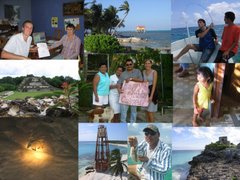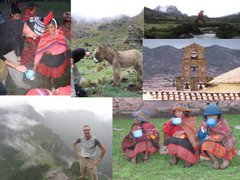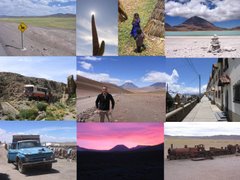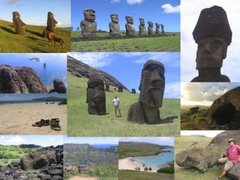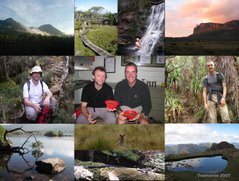 The sight that greeted Captain Cook as he discovered French Polynesia way back in the day (by which I mean I can't remember the date).
The sight that greeted Captain Cook as he discovered French Polynesia way back in the day (by which I mean I can't remember the date). You wouldn't think Tahiti would be a difficult place to love - even if it is French... but my first few hours in what was once perhaps the dictionary definition of paradise didn't feel like the start of a love affair - pas de tout.

It all started before i'd even landed, arguably before I'd even taken off. Flying into Tahiti and seeing hundreds of verdant, volcanic mountains stretched across 2.5m sq kms of the Pacific must be an incredible experience. Not that i'll ever know as - for some French beaurocratic reason or other - all international departures and arrivals take place in the middle of the night. So it was that I arrived at 1am, with 5 hours of jet lag, queued for an hour to get through passport control (they aren't that picky at Calais), and emerged from the terminal building into a cyclone.
No, really. I'm not exaggerating. Cyclone Arthur had been working its merry way through French Polynesia for two weeks before my flight touched down on the 26th. Something the pilots kept very quiet about when they gave their 'welcome to Tahiti where the local time is...' speech. I should have suspected something was up though when we were still flying through cloud as the wheels were reaching for the tarmac.
 Drenched. This is the look of a man who has lived through a cyclone - clearly insane...
Drenched. This is the look of a man who has lived through a cyclone - clearly insane...After the passport fiasco, myself and some friends i'd met on Easter Island cautiously emerged from the terminal looking for somewhere to sleep for a few hours. The Lonely Planet had
 promised that a cheap (for Tahiti) youth hostel was a few hundred meters from the terminal - perhaps a five minute walk. Had this been the case, I might have been merely drenched rather than completely saturated. However, the people of Tahiti seem to switch off all of their lights at night (I guess electricity must be just as expensive as every other darned thing there) and with the biblical downpour blurring our vision and our inability to read French signs, we toured around the outskirts of the airport for a good 30 minutes in apocalyptic weather conditions. Just as we wondered if the hostel was perhaps buried a few hundred metres under the terminal, the derelict and darkened shed we'd passed a number of times turned out - on closer inspection - to be the hostel. Sadly there were only 4 beds for 6 of us. Apologies to Lucy and Khalind who had to go out again into the torrent - your nobility on French soil will forever be remembered. This was particularly tough on Khalind, who not only managed to remain good humoured throughout but actually started chuckling to himself as the deluge reached it's climax. A possible candidate for a modern-day re-enactment of the Great Flood i reckon...
promised that a cheap (for Tahiti) youth hostel was a few hundred meters from the terminal - perhaps a five minute walk. Had this been the case, I might have been merely drenched rather than completely saturated. However, the people of Tahiti seem to switch off all of their lights at night (I guess electricity must be just as expensive as every other darned thing there) and with the biblical downpour blurring our vision and our inability to read French signs, we toured around the outskirts of the airport for a good 30 minutes in apocalyptic weather conditions. Just as we wondered if the hostel was perhaps buried a few hundred metres under the terminal, the derelict and darkened shed we'd passed a number of times turned out - on closer inspection - to be the hostel. Sadly there were only 4 beds for 6 of us. Apologies to Lucy and Khalind who had to go out again into the torrent - your nobility on French soil will forever be remembered. This was particularly tough on Khalind, who not only managed to remain good humoured throughout but actually started chuckling to himself as the deluge reached it's climax. A possible candidate for a modern-day re-enactment of the Great Flood i reckon...So I had a bed, and managed several hours' sleep before being woken by jet lag. Another friend - Roland - and I resolved that, though we were hungry, thirsty and narcoleptic, and though our credit cards wouldn't work in any of the French ATMs, we had to galvanise ourselves and get as far away from Tahiti airport as humanly possible.
And that's when it all started to get better. Our first step was to take the ferry to Moorea, an hour from Tahiti. What a great decision that turned out to be. This small island was discovered by Captain Cook in the late 18th century (he certainly got about that guy) and is, allegedly, a contender alongside Bora Bora for most beautiful island in the word. Within hours of arriving there, the rain stopped and the sun even tried to come out. We later discovered the full extent of our good fortune - the tail of the cyclone had cleared away just that morning.

As well as great scenery, superb beaches and incredibly warm sea-water, Moorea is a great place for diving. After a fairly quiet evening, I got up at 8am to do a dive, which i was promised would feature some fairly large sharks. And though the visiblity wasn't great, I did see a whole host of fish that I hadn't seen before including Lemon Sharks (fairly big) and Black Tipped Reef Sharks (medium sized).
So how to sum up Tahiti...
I could mention that the banknotes are ridiculously big, the locals insist on speaking French when I'm trying to learn Spanish, and everyone drives a renault, citreon or peugot, which is fair enough in gay Paris, but in the middle of the Pacific???
But I'd rather make a point of the fact that, despite only having 2 days to make an impression, and beginning with the worst start imaginable, Tahiti left me with some very pleasant memories. And how many Scotsmen can say they've lived through a cyclone? (Actually, if you've been to Aberdeen in the winter, ie September to May...)
So overall I'd recommend Tahiti to anyone not on a budget. But if you're going in January, check the weather forecast first.
 The crystal-clear waters and (sometime) blue-skies of French Polynesia.
The crystal-clear waters and (sometime) blue-skies of French Polynesia.

















